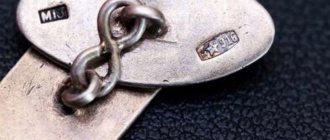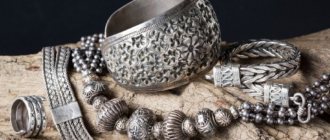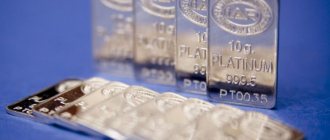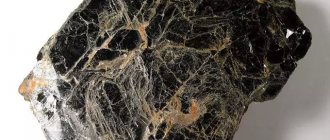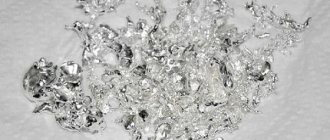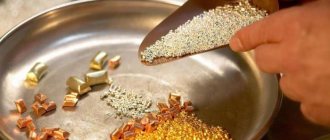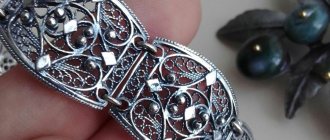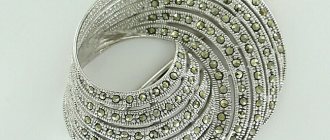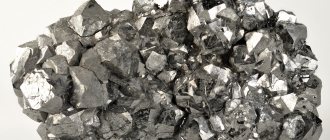History of silver
Silver is a precious metal that, along with gold, has been considered a symbol of prestige and high social status for many centuries. It was known to our ancestors back in prehistoric times.
Natural deposits of silver are extremely rare, so until the 2nd millennium BC. this metal was valued twice as much as gold
In ancient Babylon and Assyria, silver jewelry was given sacred meaning, and the metal itself was a symbol of the Moon.
In the 18th century, silver began to be used to make dishes and household items, which for a long time were available only to members of the nobility and high society. Many countries still use silver to mint coins.
Mirrors
Silver is capable of displaying up to 97% of visible light. Therefore, metal is used to make some mirrors, while for
conventional mirrors use aluminum. Previously, only the richest people could afford to buy a mirror. Various magical properties were attributed to these objects, so mirrors cost fabulous amounts of money.
The oldest silver mirror is 5 thousand years old. Today, silver mirrors provide energy for thermal power plants in California and desalination plants in Saudi Arabia.
Being in nature
There are two types of deposits of this precious metal: 1. Silver deposits, which are 50% or more silver. 2. Complex deposits in which silver is present as an associated component in the composition of other ores and metals. They make up the main reserves of the precious metal - about 80%.
Silver in nature and its designation in the periodic table
Peru is considered the leader in silver production (3,600 tons per year), followed by Mexico (3,000 tons per year) and Russia (2,500 tons). Also, deposits of this metal are actively being developed in China, Poland, Kazakhstan, Romania, and many other countries. Surprisingly, silver can also be found in native form. There are several impressive facts about the discovery of huge silver nuggets.
In 1477, a silver plate weighing 20 tons and about 30 m long was found in Canada at the Cobalt mine. The find was called the “Silver Pavement.” Another plate weighing 612 kg, found in the same mine, is currently stored in the Canadian government building
Chemical and physical properties
Silver is an incredibly malleable silvery-white metal that is heavier than copper but lighter than lead. Its density is 10.5 g/cm³. Over time, silver jewelry tarnishes: the metal reacts to hydrogen sulfide residues in the air. Thus, a sulfide coating with a characteristic pinkish tint forms on the surface of the product.
Treatment of silver with a special rhodium coating
Since the precious metal is very soft, an alloy of silver and other metals is usually used to make jewelry: copper, platinum, germanium, zinc and even silicon.
In some cases, to give the product shine and strength, the jewelry is coated with a layer of rhodium. Rhodium is a durable silver-colored metal that is resistant to scratches and damage.
Food supplement
Today, silver is sometimes used in the food industry, where it is better known as additive E174. It is used to decorate confectionery products, but only in minimal quantities.
By the way, it is also present in natural products, for example, there is a lot of it in ordinary egg yolk. However, gold can also be edible and is popular as an ingredient in luxury dishes and desserts.
Application
In ancient times, it was believed that werewolves, vampires and other evil spirits were afraid of silver. Silver jewelry was used as a talisman and protection from evil forces. The healing properties of the metal have been known since ancient times. Thus, in ancient Egypt, doctors covered wounds with thin silver plates, and used silver dishes for long-term storage and disinfection of water. Research by modern scientists has shown that silver ions actually destroy harmful bacteria and microorganisms. A number of medications are also produced based on it. This metal is also used in the chemical industry as a catalyst. Silver is widely used in the production of electronics and batteries, tableware and, of course, jewelry.
Financial experts also note that in the context of the global economic crisis, silver is a profitable investment. The price of precious metals does not depend on the devaluation of the national currency and inflation.
Money
In Ancient Rus', silver bars often served as monetary equivalent. Silver ingots resembled wooden blocks. If the price for a product turned out to be lower than a silver bar, then it was cut into pieces and taken exactly as much as the purchase cost. Such chopped parts were called “rubles”, because they literally were such. This is where the name of Russian money comes from.
Silver in jewelry
The main use of silver is in the production of jewelry. Since metal in its pure form is not strong enough, alloys of silver and other materials are used to make jewelry. This is usually copper, which provides a sufficient degree of wear resistance. Gold, platinum, tin and zinc are also used. The process of joining metals is called “alloying”.
Rhodium silver jewelry with zirconium and topaz stones
In addition, an alloy of silver and cadmium is used to make luxury jewelry, which gives the product a unique shine and high strength. Due to the high cost of cadmium, such jewelry costs several times more than gold.
Disruptions in paper markets
The physical gold market is valued at approximately $10-$12 trillion, while paper futures are worth many times that amount. Under normal market conditions, the price of physical gold is slightly higher than the spot price, which is determined by trading in the futures market.
However, there was widespread disruption last April when the pandemic forced the closure of some of the major processing plants, leading to a shortage of gold and silver bullion for delivery. This caused liquidity problems in the futures market and significantly wider spreads than usual.
Most futures contracts are rolled over or settled in cash. However, it is possible to receive physical delivery. The difference between the active COMEX contract and the spot price is known as the exchange-for-physical (EFP). This is usually a fairly nominal amount and relatively stable, but it increased significantly due to the pandemic and did not stabilize until September.
Market makers typically take a short futures position to serve their clients and hedge it with a long London OTC position, but the pandemic has raised concerns that shipping the precious metal across the Atlantic may not be possible if dealers need to make delivery on their paper positions. This caused a rush to buy short futures, pushing their price higher than the spot price.
The movement gained momentum as rising EFPs increased potential liability and further reduced futures supply. Ultimately, however, the risk did not materialize, and market makers made very high profits by selling expensive futures and delivering cheaper physical commodities against them.
The positioning of speculative paper gold investors is a useful indicator of market sentiment. Net long positions on the COMEX peaked at 1,209 tonnes in February 2021 as pandemic fears intensified, but they then declined and have only recently begun to rise again. This suggests momentum could build again if the net long position for May is 724 tonnes.
Silver samples
The test mark on a piece of jewelry shows what percentage of silver is included in the alloy. There are 6 hallmarks of silver in Ukraine - 960, 925, 916, 875, 800 and 750. Each piece of jewelry must be stamped with a hallmark.
- The 960 standard contains 96% silver and an admixture of copper or platinum. 960 standard metal is used to make filigree items. Unfortunately, such jewelry is very delicate and easily deformed if handled carelessly.
- 925 standard contains 92.5% precious metal. In addition to copper, germanium, zinc and even silicon can be added to the alloy.
- The 916 standard contains 91.6% silver; this metal is used to make cutlery.
- The 875th sample is considered the most budget-friendly, containing only 87.5% silver. Often used to make jewelry and tableware. Products made from this metal are quite low in cost.
- 800 and 750 are used only for making silverware. The metal contains 80 and 75% silver. The rest is made up of impurities. Due to the high copper content, the alloy has a reddish tint and oxidizes quickly
Interesting statistics
Each person eats approximately 0.1 mg of silver per day along with regular food. Most of it accumulates in the brain. Silver is so ductile that one gram of it is enough to make a 2-kilometer-long wire. This metal is officially a food additive. It is registered under No. 174. Over half of all silver produced is used to make photographs and films. If you have argentum halide, it won't take more than a minute to turn your regular glasses into sunglasses.
← 10 unusual gold items↑ Information about goldGolden supercar McLaren F1 →
Caring for silver jewelry
To add shine, durability and strength, some silver jewelry is plated with rhodium. Usually, in such cases, you can find the letter P on the tag. Rhodium-plated silver does not need to be cleaned, it does not turn black and retains its shine throughout the entire period of use. The only negative is that the protective coating wears off over time, so it will need to be renewed at a jewelry workshop.
Silver jewelry that is not rhodium plated may darken over time and therefore requires careful care . Jewelry should be periodically cleaned using special solutions or dry tooth powder and a brush.
Cleaning silver jewelry at home
Many people mistakenly believe that silver jewelry is significantly inferior to gold jewelry in quality and prestige. But that's not true. Modern technologies for processing metals and precious stones allow designers to create real masterpieces of jewelry from silver, which are in no way inferior to gold jewelry.
Sensitivity
Silver is extremely sensitive to environmental changes. A silver product can retain its shine for many years, and then suddenly darken. Each time this means that some parameter of the environment that is important for this metal has changed. This could be the chemical composition of the air, humidity, etc. If your jewelry suddenly begins to darken, first check the metal sample, then pay attention to the surrounding environment. Sometimes the cause of darkening is a change in cosmetic product.
